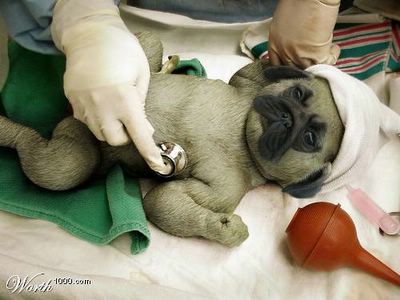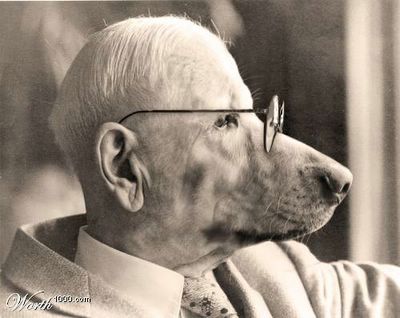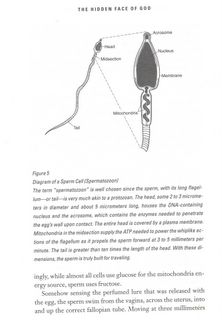
"Don't look at me." says dogman....

Why it doesn't happen:
...specially shaped protein on the egg. No foreigners are allowed; a wrong species’ sperm would waste an egg. Only if the match is proper can the sperm force its way in, and fertilization occur. A new potential life is under way. Entrance of the sperm stimulates calcium ion channels in the egg’s wall to open. This immediately closes the egg’s membrane to all other invaders. One is company. Two’s a crowd, genetically speaking. The closure is first induced by a change in the electrical charge across the membrane, and then by a release of a chemical hardener that cross-links the gelatinous outer membrane coating.(The Hidden Face of God: Science
The sperm is now within the egg, but it is kept at bay. The egg still has a full set of chromosomes, twenty-three pairs. Half must be discarded. At this stage the egg undergoes meiotic division, division without chromosome replication. Though the egg’s chromosomes are divided equally between the two new cells, as before, almost all the cytoplasm is concentrated in one daughter cell, that which contains the sperm’s nucleus. This done, the sperm and egg each duplicate their respective twenty-three chromatids, motor proteins move the two nuclei together, the nuclear membranes open, and the chromatids mingle, each finding and pairing with its corresponding partner. Spindle fibers and motor proteins then pull one member of each pair to opposite poles, two nuclear membranes form, and mitotic cellular division occurs. Another bio-ballet, a coordinated dance of molecules within the body, has passed. A few days and several further mitotic divisions will go by before this new bit of life reaches the uterus.
At this point, one has to bend over backward to accept that all of these necessary and interwoven steps have evolved randomly. There are only two forms of reproduction, mitosis and meiosis. There are no intermediate forms visible in nature. Yet somehow, according to evolutionists, a batch of lucky mutations allowed meiosis to blossom on the tree of life.
In human reproduction, meiosis gives way to mitosis, but with an amazing twist to the mitotic principle of daughter cells being replicas of the parent. As the cells divide, some of the daughters discover or interpret how and where to become the cells of a heart, and some a nose or toe. How this miracle of structuring occurs remains a speculative mystery. The knowledgeable differentiation among the newly forming cells appears in principle to be orchestrated by concentration gradients of specific molecules within the cluster of cells, but the wonder of it remains. Who or what supplied the scheme? Wisdom is encoded in the very stuff on which it must act, the blueprint and the builder all in one.
Reveals the Ultimate Truth
By Gerald L. Schroeder :77-78)

No comments:
Post a Comment